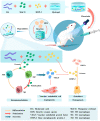Hydrogel Drug Delivery Systems for Bone Regeneration
- PMID: 37242576
- PMCID: PMC10220938
- DOI: 10.3390/pharmaceutics15051334
Hydrogel Drug Delivery Systems for Bone Regeneration
Abstract
With the in-depth understanding of bone regeneration mechanisms and the development of bone tissue engineering, a variety of scaffold carrier materials with desirable physicochemical properties and biological functions have recently emerged in the field of bone regeneration. Hydrogels are being increasingly used in the field of bone regeneration and tissue engineering because of their biocompatibility, unique swelling properties, and relative ease of fabrication. Hydrogel drug delivery systems comprise cells, cytokines, an extracellular matrix, and small molecule nucleotides, which have different properties depending on their chemical or physical cross-linking. Additionally, hydrogels can be designed for different types of drug delivery for specific applications. In this paper, we summarize recent research in the field of bone regeneration using hydrogels as delivery carriers, detail the application of hydrogels in bone defect diseases and their mechanisms, and discuss future research directions of hydrogel drug delivery systems in bone tissue engineering.
Keywords: bone immunomodulation; bone regeneration; cartilage regeneration; drug delivery systems; hydrogels; mesenchymal stem cells; tissue engineering.
Conflict of interest statement
The authors declare no conflict of interest.
Figures



Similar articles
-
Hydrogel promotes bone regeneration through various mechanisms: a review.Biomed Tech (Berl). 2024 Nov 22;70(2):103-114. doi: 10.1515/bmt-2024-0391. Print 2025 Apr 28. Biomed Tech (Berl). 2024. PMID: 39571066 Review.
-
Drug delivery systems based on polyethylene glycol hydrogels for enhanced bone regeneration.Front Bioeng Biotechnol. 2023 Jan 30;11:1117647. doi: 10.3389/fbioe.2023.1117647. eCollection 2023. Front Bioeng Biotechnol. 2023. PMID: 36793443 Free PMC article. Review.
-
A self-healing, magnetic and injectable biopolymer hydrogel generated by dual cross-linking for drug delivery and bone repair.Acta Biomater. 2022 Nov;153:159-177. doi: 10.1016/j.actbio.2022.09.036. Epub 2022 Sep 22. Acta Biomater. 2022. PMID: 36152907
-
Functional Hydrogels and Their Applications in Craniomaxillofacial Bone Regeneration.Pharmaceutics. 2022 Dec 31;15(1):150. doi: 10.3390/pharmaceutics15010150. Pharmaceutics. 2022. PMID: 36678779 Free PMC article. Review.
-
Subchondral bone-inspired hydrogel scaffold for cartilage regeneration.Colloids Surf B Biointerfaces. 2022 Oct;218:112721. doi: 10.1016/j.colsurfb.2022.112721. Epub 2022 Jul 25. Colloids Surf B Biointerfaces. 2022. PMID: 35905590
Cited by
-
Application of Antioxidant Compounds in Bone Defect Repair.Antioxidants (Basel). 2024 Jun 28;13(7):789. doi: 10.3390/antiox13070789. Antioxidants (Basel). 2024. PMID: 39061858 Free PMC article. Review.
-
The impact of graphene quantum dots on osteogenesis potential of Wharton's jelly mesenchymal stem cells in fibrin hydrogel scaffolds.Cytotechnology. 2025 Feb;77(1):14. doi: 10.1007/s10616-024-00672-9. Epub 2024 Dec 10. Cytotechnology. 2025. PMID: 39665046
-
Exploring the frontiers: The potential and challenges of bioactive scaffolds in osteosarcoma treatment and bone regeneration.Mater Today Bio. 2024 Sep 29;29:101276. doi: 10.1016/j.mtbio.2024.101276. eCollection 2024 Dec. Mater Today Bio. 2024. PMID: 39444939 Free PMC article. Review.
-
Challenges and future perspectives in using mesenchymal stem cells for efficient bone fracture healing.Front Bioeng Biotechnol. 2025 May 30;13:1568914. doi: 10.3389/fbioe.2025.1568914. eCollection 2025. Front Bioeng Biotechnol. 2025. PMID: 40521093 Free PMC article. Review.
-
The combination of hydrogels and rutin-loaded black phosphorus nanosheets treats rheumatoid arthritis.Mater Today Bio. 2024 Sep 27;29:101264. doi: 10.1016/j.mtbio.2024.101264. eCollection 2024 Dec. Mater Today Bio. 2024. PMID: 39403316 Free PMC article.
References
-
- Armiento A.R., Hatt L.P., Sanchez Rosenberg G., Thompson K., Stoddart M.J. Functional Biomaterials for Bone Regeneration: A Lesson in Complex Biology. Adv. Funct. Mater. 2020;30:1909874. doi: 10.1002/adfm.201909874. - DOI
Publication types
Grants and funding
- 81870746/National Natural Science Foundation of China
- 2022ZYD0082/Special Project for Local Science and Technology Development Guided by the Central Govern-ment of Sichuan Province
- 2022NSFSC0599/Project of Science & Technology Department of Sichuan Province
- 2020LZXNYDZ09/Joint project of Luzhou Municipal People's Government and South-west Medical University
- 2021ZKZD009/Key Program of Southwest Medical University
LinkOut - more resources
Full Text Sources

